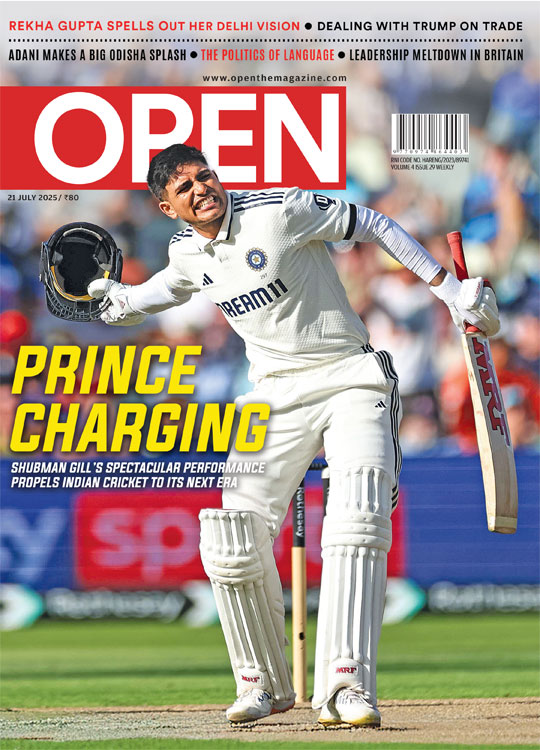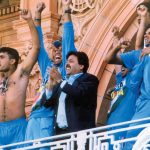Who Will Catch the Rainbow?
The fragmentation of the OBC vote
/wp-content/uploads/2016/08/Rainbow.jpg)
IN UTTAR PRADESH, where a caste calculus dominates electoral politics, most parties are busy attempting caste coalitions that could give them winning numbers. Other Backward Classes (OBCs) form the state’s largest caste group and hence there is a massive scramble for OBC votes. However, OBCs are not a homogenous group. The UP government puts them in three broad categories. First, there is the single caste of Yadavs or Ahirs; second, in the ‘more backward’ category, there are eight castes: Sonars, Jats, Kurmis, Giris, Gujjars, Gosains, Lodhs and Kambojs; and, third, in the ‘most backward’ category, there are 70 castes: Mauryas, Kushwahas, Gaderias, Kewats/ Nishads, Mallahs and Kahars, among others. While Yadavs (20 per cent) and more-backwards (19 per cent) have a roughly equal share of the OBC population, most-backwards with 61 per cent dominate the broad group.
For the 2017 Assembly polls, all four major players—the Congress, BJP, BSP and SP—have state presidents who are OBCs. The SP’s Akhilesh Yadav comes from the first category of upper OBCs. Raj Babbar of the Congress is of Sonar lineage from among the second category of more-backwards. The BSP’s Ram Achal Rajbhar and BJP’s Keshav Prasad Maurya both come from the third category of most-backwards. That pushes Chief Minister Akhilesh Yadav into fighting not only an electoral battle with political rivals, but also a caste battle with more-backwards and most-backwards for OBC votes.
The population of UP was 199 million in 2011; today, it is above 215 million. The Census puts the Dalit and Muslim share of the state population at 21 per cent and 19 per cent, respectively. But OBCs are the largest caste group, estimated at 40 to 54 per cent of UP’s population by different agencies (NSSO: 41 per cent, Mandal Commission: 52 per cent, Hukum Singh Committee: 54 per cent). If we take NSSO figures, the lowest for OBCs, then the state’s upper castes—namely Brahmins, Thakurs, Banias and Kayasths— could be the remaining 19 per cent. This arithmetic explains the political importance of OBCs.
The Indian Constitution does not mention OBCs. The First Amendment Act of 1951 inserted Article 15(4) for the state to make special provisions for the advancement of any ‘socially and educationally backward classes of citizens’ or for Schedule Castes (SCs) and Scheduled Tribes (STs). There were all-India lists for SCs and STs in existence, but nobody knew who constituted other ‘backward classes’. It was the Kaka Kalelkar and Mandal Commissions, the first and second Backward Class panels set up under Article 340 of the Constitution, that put in place caste criteria for determining social and educational backwardness. Hence, after excluding SCs and STs, all castes that qualified for social and educational backwardness came to be addressed as ‘other backward classes’ (OBCs).
The mobilisation of OBCs in UP was attempted through different movements. It was part of the socialist movement under Dr Ram Manohar Lohia during the 1950s, the agrarian one led by Charan Singh in the 1960s, and the Backward and Minority Communities Employees Federation (BAMCEF) movement under Kanshi Ram in the 1970s. Dr Lohia was the first to advocate caste- based mobilisation, yet he was against casteism and issued a call for a ‘jaati todo andolan’ (abolish caste movement). But the ‘backward- class’ mobilisations by Charan Singh and Kanshi Ram took anti- Dalit and pro-Dalit trajectories respectively and degenerated into caste agitations.
The acceptance of the Mandal Commission’s recommendations in 1989 gave UP’s backward caste movement tremendous energy. It had three salient features. One, it developed horizontally, rose upwards and then percolated downwards. Two, peasants, government servants and caste parties were instrumental in it. Three, it saw a new model of mobilisation develop that was different from the one used in Bihar (through peasant mobilisation) and Madhya Pradesh and Rajasthan (co-option by Congress and BJP). Reservation quotas in jobs and educational institutions through Mandal and in municipal and panchayat bodies through the 73rd and 74th Constitutional amendments resulted in all-round political empowerment of OBCs, giving them a robust role in politics.
It was on 5 December 1989 that OBCs gained real political control of UP politics, the day ND Tiwari of the Congress passed the chief ministerial baton to Mulayam Singh Yadav. The event signified a victory of anti-Congressism and marked the end of this party’s rule in UP. Yadav was a Lohiaite, but when Lohia died in 1967, he came under the spell of Charan Singh. However, Mandal divided the OBC movement into Jat and non-Jat factions, as the former were not classified as OBCs then. After Charan Singh’s death in 1987, his party, the Lok Dal got split into Lok Dal (A) and Lok Dal (B), the former headed by Jat leader and Charan’s son Ajit Singh and the latter by non-Jat OBC Mulayam Singh Yadav. When the latter became Chief Minister of UP, there were expectations that he will give another boost to OBC mobilisation and politics. But he started his political stint on the planks of socialism and secularism. Unfortunately, he did not carry forward even those values and allowed them to degenerate into crony-socialism and pseudo- secularism. Today, the SP is touted as a party without samajwad (socialism) and one which substituted minority appeasement for secularism.
Right from the start, Mulayam neglected the homogenisation of backward castes that was needed to strengthen the OBC movement and create a robust political party of backwards
Known as a party of OBCs, the SP was formed in 1992 and contested UP Assembly polls for the first time the following year. The party showed a steadily rising electoral graph in terms of seats and vote share. In 1993, it got 109 seats and 17.8 per cent votes. In 1996, 110 seats and 21.8 per cent votes. In 2002, 143 seats and 25.4 per cent. In 2007, it only won 97 seats but saw a marginal increase in vote share above 25.4 per cent. In 2012, it got 224 seats and 29.2 per cent votes.
Yadavs and Muslims have been two strong support groups of the party, which has usually drawn 70 per cent of Yadav and 50 per cent of Muslim votes in UP. But in the 2012 polls, only 66 per cent of Yadavs and 39 per cent of Muslims supported the party. Yet, the SP comfortably won its biggest victory ever. The reason was that the shortfall in its traditional support base was made up by fresh accretions among upper castes, more-backwards, most-backwards and Dalits. That was a glorious moment for the party and many thought that it was becoming inclusive and development centric, and losing its tag of harbouring criminals.
THE 2014 GENERAL Election results were a huge disappointment for the SP and its supremo Mulayam Singh Yadav. Despite 58 per cent Muslim support for the party, its vote bank stood depleted. All its candidates were defeated except those from the party chief’s family. He himself won two Lok Sabha seats (Azamgarh and Mainpuri), his daughter- in-law won Kannauj, and nephews Dharmendra Yadav and Akshay Yadav won Badaun and Ferozabad. Mulayam later vacated the Mainpuri seat for his grandnephew Tej Pratap Yadav, who was elected in a bypoll.
Why did all social denominations except Muslims desert the SP in 2014? Was something changing in the state’s OBC politics, and if so, why? It appears that the SP was losing grip of its support base on account of its renunciation of the principles of its ideological mentor Dr Lohia. Its neglect of samajwad has been too blatant to warrant any investigation. The party has not been able to overcome its infamous casteist mentality or its links to criminality and corruption. Even Mulayam Singh Yadav has publicly and repeatedly warned his party men to stay away from land-grabbing, nepotism and other ills if they want to remain relevant in state politics. But who is to blame for this sorry state of affairs in the party?
Right from the start, Mulayam neglected the homogenisation of backward castes that was needed to strengthen the OBC movement and create a robust political party of backwards. But they got fragmented into several sub-groups and were subsumed in different political formations. The OBC movement suffered from (a) lack of class orientation, degenerating into a caste movement, (b) petty sub-caste interests dominating the meta-narrative of OBCs where being Yadav, Kurmi, Koeri, Lodh or Mallah was more important than being OBC, and (c) lack of pan-UP character, remaining confined mostly to western UP and the Braj area. In addition, agrarian concerns in the Samajwadi movement were put on the backburner. Thus, Mulayam himself laid the foundation for the party’s decline. There was no one to correct him and he surrendered the natural leadership of OBCs in UP.
The recent dynamics of OBC politics may enable UP to return to the erstwhile rainbow coalition of post-1947 Congress. OBC fragmentation could strengthen such a coalition
The arrival of Narendra Modi as BJP’s prime ministerial candidate in the 2014 Lok Sabha election transformed the OBC discourse. Before his arrival, nobody knew his caste. The credit—or lack thereof—for revealing Modi’s caste goes to Mani Shankar Aiyar of the Congress, whose chaiwaala jibe became a potent electoral weapon in the BJP leader’s hand. Though he never revealed his caste at any public rally, word spread like wildfire that Modi too belonged to an OBC group. In field studies by the CSSP, during the 2014 Lok Sabha campaign, it was noticed that OBCs took time to imbibe this idea, and as the election approached, their reluctance to vote Modi grew weaker and weaker. In ballot booths, OBCs massively voted in his favour; 26 per cent Yadavs, 53 per cent more-backwards and 57 per cent most-backwards voted BJP. Even rural and poor voters who used to vote SP and BSP earlier voted for his party.
Did OBCs vote Modi because of his caste? The monopolisation of OBC politics by Mulayam hinged on identity politics using an exclusionary frame. But the 2014 election is classic case of people’s desire to vote for development, not caste, provided there’s an option. While Modi’s OBC caste may have been a factor in swinging non-traditional voters towards BJP, it also sent a warning signal to the SP. In contradistinction to SP’s Akhilesh Yadav, BJP’s Modi conducted his electoral campaign on a single plank of development that promoted an inclusive frame with such phrases as ‘sabka saath, sabka vikas’ and ‘125 crore deshwaasi’. Today, people do not want a marriage model of their relationship with any party; they see parties as different stocks and are willing to go for one that promises them best returns. Modi appeared to address not only the political man but also the economic man through his promise of inclusive development. Since people were unhappy with development models of the Congress-led UPA at the Centre and Akhilesh-led SP government in UP, they wanted to give Modi a chance. Ideology became irrelevant; development acquired the notion of ideology.
THE SP HAS generally been seen as a flag carrier of OBC politics in UP. But post-2014, a sudden change in the OBC discourse was discernible. With SP’s Akhilesh Yadav failing on governance and promoting Yadavisation, and BSP’s Mayawati neglecting her social engineering, political space was created for Modi to step in and appeal to more- and most-backwards on one hand, and Dalits on the other. With the BJP getting the support of all social denominations, it became clear that OBCs and Dalits should not be seen as exclusive voters of the SP and BSP respectively.
That gave BJP the confidence to reach out to them, especially OBCs. While Yadavs had been consistently voting SP, the more- and most-backward voters were divided among all parties. The BJP made a smart move by appointing Keshav Prasad Maurya as party president in UP. This indicated that it was ready to intervene effectively in the state’s OBC discourse. As if to help with that, senior BSP leader Swami Prasad Maurya (of a most-backward group) deserted his party, alleging that Mayawati had turned the party into a capital venture. After some dilly-dallying, he joined the BJP, for which he is a great catch for it strengthens its appeal among OBCs, especially most-backwards. If the BJP is able to harmonise the two Mauryas and synchronise their political clout, it could gain the community’s full support, which could make a big difference to its electoral fortunes.
The arrival of Bihar Chief Minister and JD-U President Nitish Kumar in UP is another reason that OBC politics is changing. Nitish is Kurmi, a section whose votes in UP have been going to all parties, though 2014 saw their consolidation in favour of BJP, with 53 per cent of them voting for it. The incumbent SP is nervous because Nitish may take away its Kurmi votes. To offset that, Mulayam successfully persuaded Kurmi leader Beni Verma to desert the Congress and return home. Verma was a founder member of the SP, but it’s not known if he still has any sway over his Kurmi fraternity.
The BJP is alert to all this. In 2014, it had a pre-poll alliance with a Kurmi party, Apna Dal (AD) and allotted it two seats, Mirzapur and Pratapgarh, both of which it won. Recently, Anupriya Patel, a Kurmi MP from Mirzapur, was appointed Minister of State for Health and Family Welfare at the Centre by Modi, though owing to some family feud, her mother and AD President Krishna Patel first suspended and later expelled her from the party. Nonetheless, the appointment signals that the BJP is trying to consolidate its Kurmi base in UP.
The Congress is also worried about OBC votes, particularly after losing Beni Verma to the SP. Note its move to make Raj Babbar its president in UP. The party had done very well in the 2009 General Election, winning 21 seats when 22 per cent Kurmis and 17 per cent most-backwards had voted Congress. But the party knows that Babbar is a weak card in UP’s OBC politics, so it is trying out alternatives through poll strategist Prashant Kishor.
With such a beeline being made for OBC votes, why does Mayawati seem so indifferent to them? The exit of Swami Prasad Maurya from the BSP is intriguing. It reminds us of the 2012 Assembly polls in UP, when a few months before voting, Babu Singh Kushwaha of the most-backward category was expelled by Mayawati with disastrous consequences for her party. What is her real intent in expelling senior most-backward leaders of the party on the eve of polls? Is she doing it deliberately to help some party? In 2012, the BJP backed out of taking Kushwaha because of his tainted image, and the SP took advantage of his appeal. Most-backward support for SP jumped from 20 per cent in 2007 to 28 per cent in 2012. The 8 percentage point gain is significant for it roughly corresponds with the proportion of Kushwahas among most- backwards. Will the BJP get the same advantage this time through Swami Prasad Maurya?
Many changes are discernible in the OBC politics of UP. One, UP is headed for a fragmentation of OBCs, not their homogenisation. This could mean that Yadav domination of OBCs may soon be a thing of the past. Two, as identity politics takes a backseat, more- and most-backwards gain autonomy and assert themselves for a share of the political and developmental pie. Three, as all political parties talk of development, different OBC caste groups are willing to go with various parties that offer them accommodation and empowerment. Hence, the era of caste and ethnic parties may well be over in UP soon.
The recent dynamics of OBC politics may enable UP to return to the erstwhile rainbow coalition of the post-independence Congress. The fragmentation of OBCs into assorted political formations could strengthen such a coalition. Voters in UP have consistently given clear mandates to parties over the past decade. They gave the BSP a majority in 2007, the SP in 2012, and the BJP in the 2014 General Election. That points to social conditions emerging in UP that could lead to the formation of a wide-spectrum coalition during polls, though no political party would have a monopoly over it. The big question is: who will catch the rainbow in the 2017 polls? The issue remains wide open.

/wp-content/uploads/2025/07/Cover-Shubman-Gill-1.jpg)














More Columns
‘Fuel to Air India plane was cut off before crash’ Open
Shubhanshu Shukla Return Date Set For July 14 Open
Rhythm Streets Aditya Mani Jha